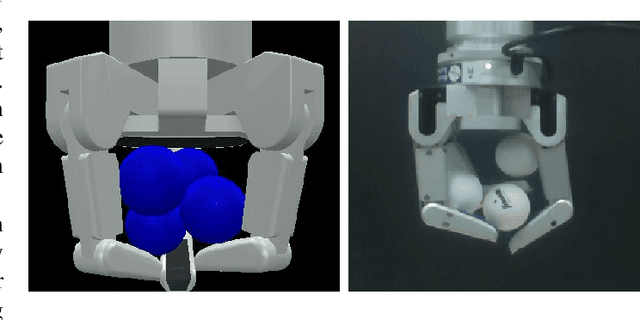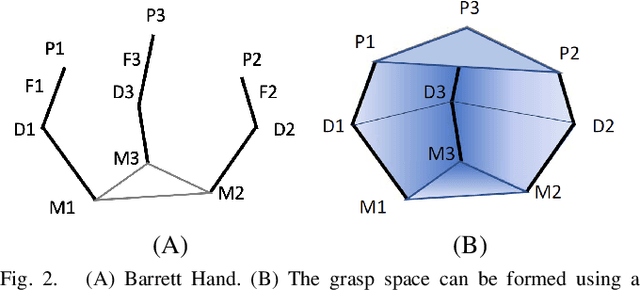Tianze Chen
Benchmarking Multi-Object Grasping
Mar 25, 2025Abstract:In this work, we describe a multi-object grasping benchmark to evaluate the grasping and manipulation capabilities of robotic systems in both pile and surface scenarios. The benchmark introduces three robot multi-object grasping benchmarking protocols designed to challenge different aspects of robotic manipulation. These protocols are: 1) the Only-Pick-Once protocol, which assesses the robot's ability to efficiently pick multiple objects in a single attempt; 2) the Accurate pick-trnsferring protocol, which evaluates the robot's capacity to selectively grasp and transport a specific number of objects from a cluttered environment; and 3) the Pick-transferring-all protocol, which challenges the robot to clear an entire scene by sequentially grasping and transferring all available objects. These protocols are intended to be adopted by the broader robotics research community, providing a standardized method to assess and compare robotic systems' performance in multi-object grasping tasks. We establish baselines for these protocols using standard planning and perception algorithms on a Barrett hand, Robotiq parallel jar gripper, and the Pisa/IIT Softhand-2, which is a soft underactuated robotic hand. We discuss the results in relation to human performance in similar tasks we well.
Unveiling the Misuse Potential of Base Large Language Models via In-Context Learning
Apr 16, 2024Abstract:The open-sourcing of large language models (LLMs) accelerates application development, innovation, and scientific progress. This includes both base models, which are pre-trained on extensive datasets without alignment, and aligned models, deliberately designed to align with ethical standards and human values. Contrary to the prevalent assumption that the inherent instruction-following limitations of base LLMs serve as a safeguard against misuse, our investigation exposes a critical oversight in this belief. By deploying carefully designed demonstrations, our research demonstrates that base LLMs could effectively interpret and execute malicious instructions. To systematically assess these risks, we introduce a novel set of risk evaluation metrics. Empirical results reveal that the outputs from base LLMs can exhibit risk levels on par with those of models fine-tuned for malicious purposes. This vulnerability, requiring neither specialized knowledge nor training, can be manipulated by almost anyone, highlighting the substantial risk and the critical need for immediate attention to the base LLMs' security protocols.
Counting Objects in a Robotic Hand
Apr 09, 2024Abstract:A robot performing multi-object grasping needs to sense the number of objects in the hand after grasping. The count plays an important role in determining the robot's next move and the outcome and efficiency of the whole pick-place process. This paper presents a data-driven contrastive learning-based counting classifier with a modified loss function as a simple and effective approach for object counting despite significant occlusion challenges caused by robotic fingers and objects. The model was validated against other models with three different common shapes (spheres, cylinders, and cubes) in simulation and in a real setup. The proposed contrastive learning-based counting approach achieved above 96\% accuracy for all three objects in the real setup.
Orthogonal Subspace Learning for Language Model Continual Learning
Oct 22, 2023Abstract:Benefiting from massive corpora and advanced hardware, large language models (LLMs) exhibit remarkable capabilities in language understanding and generation. However, their performance degrades in scenarios where multiple tasks are encountered sequentially, also known as catastrophic forgetting. In this paper, we propose orthogonal low-rank adaptation (O-LoRA), a simple and efficient approach for continual learning in language models, effectively mitigating catastrophic forgetting while learning new tasks. Specifically, O-LoRA learns tasks in different (low-rank) vector subspaces that are kept orthogonal to each other in order to minimize interference. Our method induces only marginal additional parameter costs and requires no user data storage for replay. Experimental results on continual learning benchmarks show that our method outperforms state-of-the-art methods. Furthermore, compared to previous approaches, our method excels in preserving the generalization ability of LLMs on unseen tasks.
TRACE: A Comprehensive Benchmark for Continual Learning in Large Language Models
Oct 10, 2023Abstract:Aligned large language models (LLMs) demonstrate exceptional capabilities in task-solving, following instructions, and ensuring safety. However, the continual learning aspect of these aligned LLMs has been largely overlooked. Existing continual learning benchmarks lack sufficient challenge for leading aligned LLMs, owing to both their simplicity and the models' potential exposure during instruction tuning. In this paper, we introduce TRACE, a novel benchmark designed to evaluate continual learning in LLMs. TRACE consists of 8 distinct datasets spanning challenging tasks including domain-specific tasks, multilingual capabilities, code generation, and mathematical reasoning. All datasets are standardized into a unified format, allowing for effortless automatic evaluation of LLMs. Our experiments show that after training on TRACE, aligned LLMs exhibit significant declines in both general ability and instruction-following capabilities. For example, the accuracy of llama2-chat 13B on gsm8k dataset declined precipitously from 28.8\% to 2\% after training on our datasets. This highlights the challenge of finding a suitable tradeoff between achieving performance on specific tasks while preserving the original prowess of LLMs. Empirical findings suggest that tasks inherently equipped with reasoning paths contribute significantly to preserving certain capabilities of LLMs against potential declines. Motivated by this, we introduce the Reasoning-augmented Continual Learning (RCL) approach. RCL integrates task-specific cues with meta-rationales, effectively reducing catastrophic forgetting in LLMs while expediting convergence on novel tasks.
InstructUIE: Multi-task Instruction Tuning for Unified Information Extraction
Apr 17, 2023Abstract:Large language models have unlocked strong multi-task capabilities from reading instructive prompts. However, recent studies have shown that existing large models still have difficulty with information extraction tasks. For example, gpt-3.5-turbo achieved an F1 score of 18.22 on the Ontonotes dataset, which is significantly lower than the state-of-the-art performance. In this paper, we propose InstructUIE, a unified information extraction framework based on instruction tuning, which can uniformly model various information extraction tasks and capture the inter-task dependency. To validate the proposed method, we introduce IE INSTRUCTIONS, a benchmark of 32 diverse information extraction datasets in a unified text-to-text format with expert-written instructions. Experimental results demonstrate that our method achieves comparable performance to Bert in supervised settings and significantly outperforms the state-of-the-art and gpt3.5 in zero-shot settings.
Multi-Object Grasping -- Types and Taxonomy
May 30, 2022



Abstract:This paper proposes 12 multi-object grasps (MOGs) types from a human and robot grasping data set. The grasp types are then analyzed and organized into a MOG taxonomy. This paper first presents three MOG data collection setups: a human finger tracking setup for multi-object grasping demonstrations, a real system with Barretthand, UR5e arm, and a MOG algorithm, a simulation system with the same settings as the real system. Then the paper describes a novel stochastic grasping routine designed based on a biased random walk to explore the robotic hand's configuration space for feasible MOGs. Based on observations in both the human demonstrations and robotic MOG solutions, this paper proposes 12 MOG types in two groups: shape-based types and function-based types. The new MOG types are compared using six characteristics and then compiled into a taxonomy. This paper then introduces the observed MOG type combinations and shows examples of 16 different combinations.
Multi-Object Grasping -- Generating Efficient Robotic Picking and Transferring Policy
Dec 18, 2021



Abstract:Transferring multiple objects between bins is a common task for many applications. In robotics, a standard approach is to pick up one object and transfer it at a time. However, grasping and picking up multiple objects and transferring them together at once is more efficient. This paper presents a set of novel strategies for efficiently grasping multiple objects in a bin to transfer them to another. The strategies enable a robotic hand to identify an optimal ready hand configuration (pre-grasp) and calculate a flexion synergy based on the desired quantity of objects to be grasped. This paper also presents an approach that uses the Markov decision process (MDP) to model the pick-transfer routines when the required quantity is larger than the capability of a single grasp. Using the MDP model, the proposed approach can generate an optimal pick-transfer routine that minimizes the number of transfers, representing efficiency. The proposed approach has been evaluated in both a simulation environment and on a real robotic system. The results show the approach reduces the number of transfers by 59% and the number of lifts by 58% compared to an optimal single object pick-transfer solution.
Multi-Object Grasping -- Estimating the Number of Objects in a Robotic Grasp
Nov 30, 2021



Abstract:A human hand can grasp a desired number of objects at once from a pile based solely on tactile sensing. To do so, a robot needs to grasp within a pile, sense the number of objects in the grasp before lifting, and predict the number of objects that will remain in the grasp after lifting. It is a challenging problem because when making the prediction, the robotic hand is still in the pile and the objects in the grasp are not observable to vision systems. Moreover, some objects that are grasped by the hand before lifting from the pile may fall out of the grasp when the hand is lifted. This occurs because they were supported by other objects in the pile instead of the fingers of the hand. Therefore, a robotic hand should sense the number of objects in a grasp using its tactile sensors before lifting. This paper presents novel multi-object grasping analyzing methods for solving this problem. They include a grasp volume calculation, tactile force analysis, and a data-driven deep learning approach. The methods have been implemented on a Barrett hand and then evaluated in simulations and a real setup with a robotic system. The evaluation results conclude that once the Barrett hand grasps multiple objects in the pile, the data-driven model can predict, before lifting, the number of objects that will remain in the hand after lifting. The root-mean-square errors for our approach are 0.74 for balls and 0.58 for cubes in simulations, and 1.06 for balls, and 1.45 for cubes in the real system.
 Add to Chrome
Add to Chrome Add to Firefox
Add to Firefox Add to Edge
Add to Edge